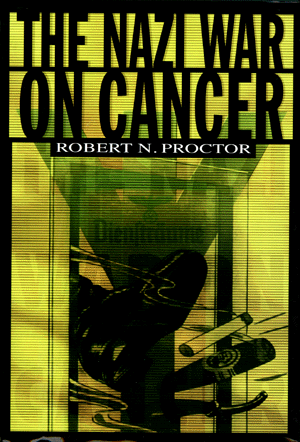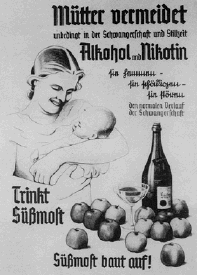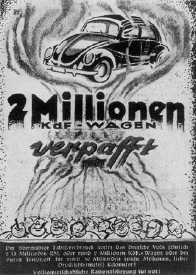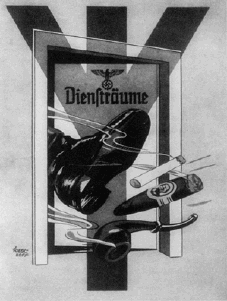
Hitler himself detested tobacco, which he called "the wrath of the Red Man against the White Man, vengeance for having been given hard liquor." But the antismoking campaign reflected "a national political climate stressing the virtues of racial hygiene and bodily purity" as well as the Fuhrer's personal prejudices. The same could be said of Nazi efforts to discourage drinking and encourage a better diet.
The state performer in antismoking propaganda was Adolf Hitler. As one magazine put it: "brother national socialist, do you know that our Führer is against smoking and think that every German is responsible to the whole people for all his deeds and emissions, and does not have the right to damage his body with drugs?"
"Robert Proctor presents a great deal of evidence that the nazis' exerted massive control over most facets of ordinary citizen's lives. Yet somehow, he never reaches the obvious conclusion that such compulsive regulations, even if arguably well intentioned, ultimately lead to a large scale sacrifice of basic freedoms.
He explains how the nazis greatly restricted tobacco advertising, banned smoking in most public buildings, increasingly restricted and regulated tobacco farmers growing abilities, and engaged in a sophisticated anti-smoking public relations campaign. (Suing tobacco companies for announced consequences was a stunt that mysteriously eluded Hitler's thugs.) Despite the frightening parallels to the current war on tobacco, Mr. Proctor never even hints at the analogy. Curiously, he seems to take an approach that such alleged concern for public health shows nazism to be a more complex dogma than commonly presumed. While nothing present in the book betokens even a trace of sympathy for the Third Reich, this viewpoint seems incredibly naive. It's easy to wonder if Hitler and company were truly concerned with promoting public health. The unquenchable lust for absolute control is a far more believable motive.
Incongruously some of the book's desultory details lend further certitude to its unpromulgated thesis. Hitler not only abstained from tobacco; he also never drank and was,for the most part--a vegetarian. Frighteningly he also was an animal rights activist. The book reruns a nazi-era cartoon depicting many liberated lab animals giving the nazi salute to Hermann Goring after he outlawed animal experimentation and promised to send violators to a concentration camp. Also included is a fitting quote -now too widely suppressed from Joseph Goebbles, `the fuhrer is deeply religious, though completely anti-Christian; he views Christianity as a symptom of decay." Controversial as it may be in some circles, such a quote proves that nazism viewed Christianity as hatefully as it did Judaism. Passing coverage is given to the Third Reich's forays into euthanasia and eugenics. Another striking morsel is the reporting of a widespread nazi-era whispered joke `What is the ideal German? Blond like Hitler. Slim like Goring. Masculine like Goebbles...' implying that Gautlier Goebble's homosexuality was common knowledge. Nazi linguistic restrictions seem to be the counterpart of modern day `hate speech.' Words such as `catastrophe,' sabotage,' and `assassination' were to be avoided, and in a portentous move, `cripple' was replaced by `handicapped. Proctor also suggests `the word `enlightenment' (was) probably used more in the nazi period than at any other time.'
Perhaps the ultimate overlooked point of this work is the suggestion that Adolph Hitler with his anti-tobacco, anti-religion, pro-animal rights, pro-government intrusion would find success as a modern day liberal." --Steve Fantina
Factoid: Did you know the three leading facist leaders (Benito Mussolini, Franco, & Adolf Hitler) all abstained from tobacco and smoking?
 
Motherhood, apple cider and Volkswagen: Virtures of abstinence include healthy infants and savings, enough for Germans to buy two million VWs.
In Nazi Germany, for instance, abstinence from tobacco was a "national socialist duty" (Hitler gave a gold watch to associates who quit the habit, though this didn't stop them lighting up in the Berlin bunker once they heard the Fuhrer had committed suicide). Armed with such senior sanction -- loyally, Reichsfuhrer Heinrich Himmler banned SS men from smoking, though not shooting, on duty, and Propaganda Minister Joseph Gobbels was obliged to hide his ciggie whenever he was filmed -- anti-tobacco activists succeeded in banning smoking from government offices, civic transport, university campuses, rest homes, post offices, many restaurants and bars, hospital grounds and workplaces. Tobacco taxes were raised, unsupervised cigarette vending machines were banned, and there were calls for a ban on smoking while driving.
Thanks to the Ministry of Science and Education, and the Reich Health Office, posters were produced depicting smoking as the typically despicable habit of Jews, jazz musicians, Gypsies, Indians, homosexuals, blacks, communists, capitalists, cripples, intellectuals and harlots. Zealous lobbyists descended into the schools, terrifying children with tales of impotence and racial impurity.
One particularly vile individual, Karl Astel -- upstanding president of Jena University, poisonous anti-Semite, euthanasia fanatic, SS officer, war criminal and tobacco-free Germany enthusiast -- liked to walk up to smokers and tear cigarettes from their unsuspecting mouths. (He committed suicide when the war ended, more through disappointment than fear of hanging.) It comes as little surprise to discover that the phrase "passive smoking" (Passivrauchen) was coined not by contemporary American admen, but by Fritz Lickint, the author of the magisterial 1100-page Tabak und Organismus ("Tobacco and the Organism"), which was produced in collaboration with the German AntiTobacco League.
If some of these measures appear familiar today, then consider the rules laid down in 1941 regarding tobacco advertising. "Images that create the impression that smoking is a sign of masculinity are barred, as are images depicting men engaged in activities attractive to youthful males (athletes or pilots, for example)," and "may not be directed at sportsmen or automobile drivers," while "advocates of tobacco abstinence or temperance must not be mocked." Advertisements were banned from films, billboards, posters and "the text sections of journals and newspapers." Nevertheless, even the Nazis couldn't equal the recent ban on smoking on death row, meaning prisoners about to undergo massive electric shocks are forbidden from indulging in "one last drag" -- talk about cruel and unusual punishment.
This great crusade, propagated through a remarkable network of lectures, re-education programs and congresses, was backed up by the medical and health establishment for the sake of "science." Or at least a certain type of junk science, one in which objective research and the scientific method was subordinated to, and bastardized for the sake of, a greater political program. Thus, it was commonly touted by scientists and racial hygienists that smoking caused "spontaneous abortions": a clearly demonstrable fallacy, but one requiring official promotion in order to ensure a high birth rate for Aryan women. (Source: Anti-tobacco Gestapo: past and present)

The anti-tobacco campaign of the Nazis: a little known aspect of public health in Germany, 1933-45
(BMJ No 7070 Volume 313)
Robert N Proctor
Historians and epidemiologists have only recently begun to explore the Nazi anti-tobacco movement. Germany had the world's strongest anti smoking movement in the 1930s and early 1940s,encompassing bans on smoking in public spaces, bans on advertising,restrictions on tobacco rations for women, and the world's most refined tobacco epidemiology, linking tobacco use with the already evident epidemic of lung cancer. The anti-tobacco campaign must be understood against the backdrop of the Nazi quest for racial and bodily purity, which also motivated many other public health efforts of the era.
Medical historians in recent years have done a great deal to enlarge our understanding of medicine and public health in Nazi Germany. We know that about half of all doctors joined the Nazi party and that doctors played a major part in designing and administering the Nazi programmes of forcible sterilisation, "euthanasia," and the industrial scale murder of Jews and gypsies.(1) (2) Much of our present day concern for the abuse of humans used in experiments stems from the extreme brutality many German doctors showed towards concentration camp prisoners exploited to advance the cause of German military medicine.(3)
Tobacco in the Reich
One topic that has only recently begun to attract attention is the Nazi anti-tobacco movement.(4-6) Germany had the world's strongest anti smoking movement in the 1930s and early 1940s,supported by Nazi medical and military leaders worried that tobacco might prove a hazard to the race.(1) (4)Many Nazi leaders were vocal opponents of smoking. Anti-tobacco activists pointed out that whereas Churchill, Stalin, and Roosevelt were all fond of tobacco, the three major fascist leaders of Europe-Hitler, Mussolini, and Franco-were all non-smokers.(7) Hitler was the most adamant,characterising tobacco as "the wrath of the Red Man against the White Man for having been given hard liquor." At one point the Fuhrer even suggested that Nazism might never have triumphed in Germany had he not given up smoking.(8)
German smoking rates rose dramatically in the first six years of Nazi rule, suggesting that the propaganda campaign launched during those early years was largely ineffective.(4) (5) German smoking rates rose faster even than those of France, which had a much weaker anti-tobacco campaign. German per capita tobacco use between 1932 and 1939 rose from 570 to 900 cigarettes a year, whereas French tobacco consumption grew from 570 to only 630 cigarettes over the same period.(9)
Smith et al suggested that smoking may have functioned as a kind of cultural resistance,(4) though it is also important to realise that German tobacco companies exercised a great deal of economic and political power, as they do today. German anti-tobacco activists frequently complained that their efforts were no match for the "American style" advertising campaigns waged by the tobacco industry.(10) German cigarette manufacturers neutralised early criticism-for example, from the SA(Sturm-Abteilung; stormtroops), which manufactured its own"Sturmzigaretten"-by portraying themselves as early and eager supporters of the regime.(11) The tobacco industry also launched several new journals aimed at countering anti-tobacco propaganda. In a pattern that would become familiar in the United States and elsewhere after the second world war, several of these journals tried to dismiss the anti-tobacco movement as "fanatic"and "unscientific." One such journal featured the German word for science twice in its title (Der Tabak: Wissenschaftliche Zeitschrift der International en Tabakwissenschaftlichen Gesellschaft, founded in 1940).
We should also realise that tobacco provided an important source of revenue for the national treasury. In 1937-8 German national income from tobacco taxes and tariffs exceeded 1 billion Reichsmarks.(12) By 1941, as a result of new taxes and the annexation of Austria and Bohemia, Germans were paying nearly twice that. According to Germany's national accounting office, by 1941 tobacco taxes constituted about one twelfth of the government's entire income.(13) Two hundred thousand Germans were said to owe their livelihood to tobacco-an argument that was reversed by those who pointed to Germany's need for additional men in its labour force, men who could presumably be supplied from the tobacco industry.(14)
Culmination of the campaign: 1939-41
German anti-tobacco policies accelerated towards the end of the 1930s,and by the early war years tobacco use had begun to decline. The Luftwaffe banned smoking in 1938 and the post office did likewise.Smoking was barred in many workplaces, government offices, hospitals,and rest homes. The NSDAP (National sozialistische Deutsche Arbeiterpartei) announced a ban on smoking in its offices in 1939, at which time SS chief Heinrich Himmler announced a smoking ban for all uniformed police and SS officers while on duty.(15) The Journal of the American Medical Association that year reported Hermann Goering's decree barring soldiers from smoking on the streets, on marches, and on brief off duty periods.(16) Sixty of Germany's largest cities banned smoking on street cars in 1941.(17) Smoking was banned in air raid shelters-though some shelters reserved separate rooms for smokers.(18) During the war years tobacco rationing coupons were denied to pregnant women (and to all women below the age of 25) while restaurants and cafes were barred from selling cigarettes to female customers.(19) From July 1943 it was illegal for anyone under the age of 18 to smoke in public.(20) Smoking was banned on all German city trains and buses in 1944, the initiative coming from Hitler himself,who was worried about exposure of young female conductors to tobacco smoke.(21) Nazi policies were heralded as marking"the beginning of the end" of tobacco use in Germany.(14)
German tobacco epidemiology by this time was the most advanced in the world. Franz H Muller in 1939 and Eberhard Schairer and Erich Schoniger in 1943 were the first to use case-control epidemiological methods to document the lung cancer hazard from cigarettes.(22) (23) Muller concluded that the "extraordinary rise in tobacco use" was "the single most important cause of the rising incidence of lung cancer."(22) Heart disease was another focus and was not infrequently said to be the most serious illness brought on by smoking.(24) Late in the war nicotine was suspected as a cause of the coronary heart failure suffered by a surprising number of soldiers on the eastern front. A 1944 report by an army field pathologist found that all 32 young soldiers whom he had examined after death from heart attack on the front had been "enthusiastic smokers." The author cited the Freiburg pathologist Franz Buchner's view that cigarettes should be considered "a coronary poison of the first order."(25)
On 20 June 1940 Hitler ordered tobacco rations to be distributed to the military "in a manner that would dissuade" soldiers from smoking.(24) Cigarette rations were limited to six per man per day, with alternative rations available for non-smokers(for example, chocolate or extra food). Extra cigarettes were sometimes available for purchase, but these were generally limited to 50 per man per month and were often unavailable-as during times of rapid advance or retreat. Tobacco rations were denied to women accompanying the Wehrmacht. An ordinance on 3 November 1941 raised tobacco taxes to a higher level than they had ever been (80-95% of the retail price).Tobacco taxes would not rise that high again for more than a quarter of a century after Hitler's defeat.(26)
Impact of the war and postwar poverty
The net effect of these and other measures (for instance, medical lectures to discourage soldiers from smoking) was to lower tobacco consumption by the military during the war years. A 1944 survey of 1000 servicemen found that, whereas the proportion of soldiers smoking had increased (only 12.7% were non-smokers), the total consumption of tobacco had decreased-by just over 14%. More men were smoking (101 of those surveyed had taken up the habit during the war, whereas only seven had given it up) but the average soldier was smoking about a quarter (23.4%) less tobacco than in the immediate prewar period. The number of very heavy smokers (30 or more cigarettes daily) was down dramatically-from 4.4% to only 0.3%-and similar declines were recorded for moderately heavy smokers.(24)
Postwar poverty further cut consumption. According to official statistics German tobacco use did not reach prewar levels again until the mid-1950s. The collapse was dramatic: German per capita consumption dropped by more than half from 1940 to 1950, whereas American consumption nearly doubled during that period.(6) (9) French consumption also rose, though during the four years of German occupation cigarette consumption declined by even more than in Germany(9)-suggesting that military conquest had a larger effect than Nazi propaganda.
After the war Germany lost its position as home to the world's most aggressive anti-tobacco science. Hitler was dead but also many of his anti-tobacco underlings either had lost their jobs or were otherwise silenced. Karl Aster, head of Jena's Institute for Tobacco Hazards Research (and rector of the University of Jena and an officer in the SS), committed suicide in his office on the night of 3-4 April 1945.Reich Health Fuhrer Leonardo Conti, another anti-tobacco activist,committed suicide on 6 October 1945 in an allied prison while awaiting prosecution for his role in the euthanasia programme. Hans Reiter, the Reich Health Office president who once characterised nicotine as "the greatest enemy of the people's health" and "the number one drag on the German economy"(27) was interned in an American prison camp for two years, after which he worked as a physician in a clinic in Kassel, never again returning to public service. Gauleiter Fritz Sauckel, the guiding light behind Thuringia's antismoking campaign and the man who drafted the grant application for Astel's anti-tobacco institute, was executed on 1 October 1946 for crimes against humanity. It is hardly surprising that much of the wind was taken out of the sails of Germany's anti-tobacco movement.
The flip side of Fascism Smith et al were correct to emphasise the strength of the Nazi anti smoking effort and the sophistication of Nazi era tobacco science.(4) The anti smoking science and policies of the era have not attracted much attention, possibly because the impulse behind the movement was closely attached to the larger Nazi movement.That does not mean, however, that anti smoking movements are inherently fascist(28); it means simply that scientific memories are often clouded by the celebrations of victors and that the political history of science is occasionally less pleasant than we would wish.
Funding: United States Holocaust Memorial Museum,Washington, DC; Hamburger Institut fur Sozialforschung in Hamburg.
Conflict of interest: None.
Department of History,
Pennsylvania State University,
University Park,
PA 16802,
United States
Robert N Proctor, professor of the history of science
1 Proctor R N. Racial hygiene: medicine under the Nazis.Cambridge, Massachusetts: Harvard University Press, 1988.
2 Kater M H. Doctors under Hitler.Chapel Hill: University of North Carolina Press, 1989.
3 Annas G, Grodin M. The Nazi doctors and the Nuremberg code.New York: Oxford University Press, 1992.
4 Smith G D, Strobele S A, Egger M. Smoking and death.BMJ1995;310:396.
5 Borgers D. Smoking and death. BMJ 1995;310:1536.
6 Proctor R N. Nazi cancer research and policy. J Epidemiol Community Health (in press).
7 Bauer D. So lebt der Duce. Auf der Wacht 1937:19-20.
8 Picker H. Hitlers Tischgesprache im Fuhrerhauptquartier.Bonn: Athenaum Verlag, 1951.
9 Lee PN, ed. Tobacco consumption in various countries. 4th ed. London: Tobacco Research Council, 1975.
10 Reid G. Weltanschauung, Haltung, Genussgifte.Genussgifte1939;35:64.
11 Kosmos. Bild-Dokumente unserer Zeit.Dresden: Kosmos,1933.
12 Reckert FK. Tabakwarenkunde: Der Tabak, sein Anbau undseine Verarbeitung.Berlin-Schoneberg: Max Schwabe, 1942.
13 Erkennung und Bekampfung der Tabakgefahren. DtschArztebl 1941;71:183-5.
14 Klarner W. Vom Rauchen: Eine Sucht und ihre Bekampfung.Nuremberg: Rudolf Kern, 1940.
15 Rauchverbot fur die Polizei auf Strassen und in Dienstraumen. Die Genussgifte1940;36:59.
16 Berlin: alcohol, tobacco and coffee. JAMA 1939;113:1144-5.
17 Kleine Mitteilungen. Vertrauensarzt 1941;9:196.
18 Mitteilungen. Off Gesundheitsdienst 1941;7:488.
19 Charman T. The German home front 1939-1945. London: Barrie & Jenkins, 1989.
20 Fromme W. Offentlicher Gesundheitsdienst. In: Rodenwaldt E,ed. Hygiene. Part I. General hygiene. Wiesbaden: Dietrich'sche Verlagsbuchhandlung, 1948:36.
21Informationsdienst des Hauptamtes fur Volksgesundheitder NSDAP. 1944;April-June:60-1.
22 Muller F H. Tabakmissbrauch und Lungencarcinom. Z Krebsforsch1939;49:57-85.
23 Schairer E, Schoniger E. Lungenkrebs und Tabakverbrauch.Z Krebsforsch1943;54:261-9.
24 Kittel W. Hygiene des Rauchens. In: Handloser S, Hoffmann W, eds. Wehrhygiene. Berlin: Springer-Verlag, 1944.
25 Goedel A. Kriegspathologische Beitrage. In: Zimmer A, ed.Kriegschirurgie. Vol 1. Vienna: Franz Deuticke, 1944.
26 Pritzkoleit K. Auf einer Woge von Gold: Der Triumph der Wirtschaft.Vienna: Verlag Kurt Desch, 1961.
27 Werberat der deutschen Wirtschaft. Volksgesundheit und Werbung. Berlin: arl Heymanns, 1939.
28 Peto R. Smoking and death. BMJ 1995;310:396.
(Accepted 6 November 1996)
Full text on BioMedNet
|